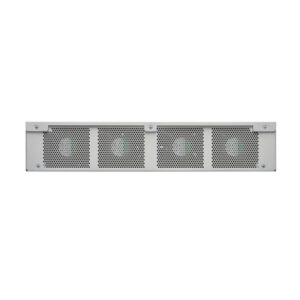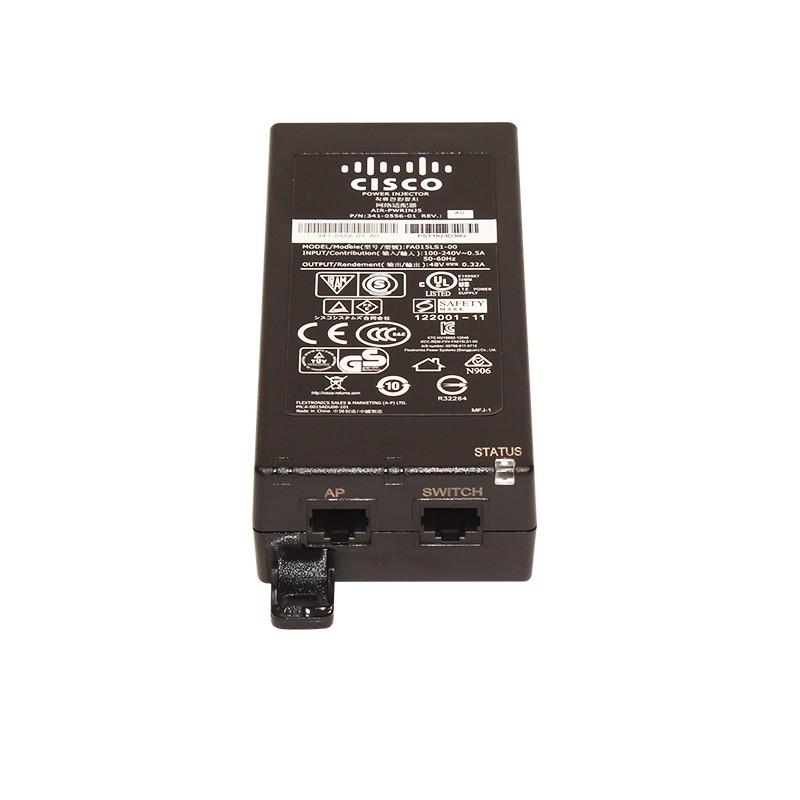



C9800-80-K9
$80,000.00
< tbody >
| Model: | C9800-80-K9 – Cisco WLAN Controller |
| Detail: | Cisco Catalyst 9800-80 Wireless Controller |
- Description
Description
C9800-80-K9 Specification |
|
| Maximum number of access points | Up to 6000 |
| Maximum number of clients | 64,000 |
| Maximum throughput | Up to 80 Gbps |
| Maximum WLANs | 4096 |
| Maximum VLANs | 4096 |
| Max site tags | 6000 |
| Max APs per site | 100 |
| Max policy tags | 6000 |
| Max RF tags | 6000 |
| Max RF profiles | 12000 |
| Max policy profiles | 1000 |
| Max flex profiles | 6000 |
| Fixed uplinks | 8x 10 GE or 6x 10 GE + 2x 1 GE SFP+/SFP |
| Modular uplinks (optional) | The supported uplink modules are:
● C9800-18X1GE(=) ● C9800-10X10GE(=) ● C9800-1X40GE(=) ● C9800-2X40GE(=) ● C9800-1X100GE(=) The uplink modules are hot-swappable. Supports 10 GE, 40 GE, and 100 GE QSFP transceivers |
| Redundant power supply | AC or DC power supply |
| Maximum power consumption with modules | 600W |
| Deployment modes | Centralized, Cisco FlexConnect®, and Fabric Wireless (SD-Access) |
| Form factor | 2RU |
| License | Smart License enabled |
| Operating system | Cisco IOS XE |
| Management | Cisco DNA Center™ 1.2.8, Cisco Prime® Infrastructure 3.5, integrated WebUI, and third party (open standards APIs) |
| Interoperability | AireOS-based controllers with 8.8 MR2, 8.5 MR4 and 8.5 MR3 special |
| Policy engine | Cisco Identity Services Engine (ISE) 2.2, 2.3, and 2.4 |
| Cisco Connected Mobile Experiences (CMX) | CMX 10.5.1 |
| Access points | Aironet 802.11ac Wave 1 and Wave 2 access points |
| Dimension (W × D × H) | 17.3 × inches × 20.5 inches × 3.47 inches
(43.94 cm × 52.07 cm × 8.81 cm) |
| Weight | 31.5 lb (14.29 kg) |
| Wireless | IEEE 802.11a, 802.11b, 802.11g, 802.11d, WMM/802.11e, 802.11h, 802.11n, 802.11k, 802.11r, 802.11u, 802.11w, 802.11ac Wave 1 and Wave 2 |
| Wired, switching, and routing | IEEE 802.3 10BASE-T, IEEE 802.3u 100BASE-TX, 1000BASE-T, 1000BASE-SX, 1000-BASE-LH, IEEE 802.1Q VLAN tagging, IEEE 802.1AX Link Aggregation |
| Data standards | ● RFC 768 User Datagram Protocol (UDP)
● RFC 791 IP ● RFC 2460 IPv6 ● RFC 792 Internet Control Message Protocol (ICMP) ● RFC 793 TCP ● RFC 826 Address Resolution Protocol (ARP) ● RFC 1122 Requirements for Internet Hosts ● RFC 1519 Classless Interdomain Routing (CIDR) ● RFC 1542 Bootstrap Protocol (BOOTP) ● RFC 2131 Dynamic Host Configuration Protocol (DHCP) ● RFC 5415 Control and Provisioning of Wireless Access Points (CAPWAP) Protocol ● RFC 5416 CAPWAP Binding for 802.11 |
| Security standards | ● Wi-Fi Protected Access (WPA)
● IEEE 802.11i (WPA2, RSN) ● RFC 1321 MD5 Message-Digest Algorithm ● RFC 1851 Encapsulating Security Payload (ESP) Triple DES (3DES) Transform ● RFC 2104 HMAC: Keyed-Hashing for Message Authentication ● RFC 2246 TLS Protocol Version 1.0 ● RFC 2401 Security Architecture for the Internet Protocol ● RFC 2403 HMAC-MD5-96 within ESP and AH ● RFC 2404 HMAC-SHA-1-96 within ESP and AH ● RFC 2405 ESP DES-CBC Cipher Algorithm with Explicit IV ● RFC 2407 Interpretation for Internet Security Association Key Management Protocol (ISAKMP) ● RFC 2408 ISAKMP ● RFC 2409 Internet Key Exchange (IKE) ● RFC 2451 ESP CBC-Mode Cipher Algorithms ● RFC 3280 Internet X.509 Public Key Infrastructure (PKI) Certificate and Certificate Revocation List (CRL) Profile ● RFC 4347 Datagram Transport Layer Security (DTLS) ● RFC 5246 TLS Protocol Version 1.2 |
| Encryption standards | ● Static Wired Equivalent Privacy (WEP) RC4 40, 104 and 128 bits
● Advanced Encryption Standard (AES): Cipher Block Chaining (CBC), Counter with CBC-MAC (CCM), Counter with CBC Message Authentication Code Protocol (CCMP) ● Data Encryption Standard (DES): DES-CBC, 3DES ● Secure Sockets Layer (SSL) and Transport Layer Security (TLS): RC4 128-bit and RSA 1024- and 2048-bit ● DTLS: AES-CBC ● IPsec: DES-CBC, 3DES, AES-CBC ● 802.1AE MACsec encryption |
| Authentication, Authorization, and Accounting (AAA) | ● IEEE 802.1X
● RFC 2548 Microsoft Vendor-Specific RADIUS Attributes ● RFC 2716 Point-to-Point Protocol (PPP) Extensible Authentication Protocol (EAP)-TLS ● RFC 2865 RADIUS Authentication ● RFC 2866 RADIUS Accounting ● RFC 2867 RADIUS Tunnel Accounting ● RFC 2869 RADIUS Extensions ● RFC 3576 Dynamic Authorization Extensions to RADIUS ● RFC 5176 Dynamic Authorization Extensions to RADIUS ● RFC 3579 RADIUS Support for EAP ● RFC 3580 IEEE 802.1X RADIUS Guidelines ● RFC 3748 Extensible Authentication Protocol (EAP) ● Web-based authentication ● TACACS support for management users |
| Management standards | ● Simple Network Management Protocol (SNMP) v1, v2c, v3
● RFC 854 Telnet ● RFC 1155 Management Information for TCP/IP-based Internets ● RFC 1156 MIB ● RFC 1157 SNMP ● RFC 1213 SNMP MIB II ● RFC 1350 Trivial File Transfer Protocol (TFTP) ● RFC 1643 Ethernet MIB ● RFC 2030 Simple Network Time Protocol (SNTP) ● RFC 2616 HTTP ● RFC 2665 Ethernet-Like Interface Types MIB ● RFC 2674 Definitions of Managed Objects for Bridges with Traffic Classes, Multicast Filtering, and Virtual Extensions ● RFC 2819 Remote Monitoring (RMON) MIB ● RFC 2863 Interfaces Group MIB ● RFC 3164 Syslog ● RFC 3414 User-Based Security Model (USM) for SNMPv3 ● RFC 3418 MIB for SNMP ● RFC 3636 Definitions of Managed Objects for IEEE 802.3 MAUs ● RFC 4741 Base NETCONF protocol ● RFC 4742 NETCONF over SSH ● RFC 6241 NETCONF ● RFC 6242 NETCONF over SSH ● RFC 5277 NETCONF event notifications ● RFC 5717 Partial Lock Remote Procedure Call ● RFC 6243 With-Defaults capability for NETCONF ● RFC 6020 YANG ● Cisco private MIBs |
| Management interfaces | ● Web-based: HTTP/HTTPS
● Command-line interface: Telnet, Secure Shell (SSH) Protocol, serial port ● SNMP ● NETCONF |
| Hard Disk Drives (HDD) | ● SATA solid-state drive (SSD)
● 240 GB of memory |
| Environmental conditions supported | Operating temperature:
● Normal: 5° to 40° C (41° to 104°F) ● Short term: 5° to 50° C (41° to 122°F) Nonoperating temperature: ● -40° to 65° C (-104° to 149°F) Operating humidity: ● Normal: 5% to 85% noncondensing ● Short term: 5% to 90% noncondensing Nonoperating temperature humidity: ● 5% to 93% at 82°F (28°C) Operating altitude: ● Appliance operating: 0 to 3000 m (0 to 10,000 ft) ● Appliance nonoperating: 0 to 12,192 m (0 to 40,000 ft) Electrical input: ● AC input frequency range: 47 to 63 Hz ● AC input range: 90 to 264 VAC with AC PEM ● DC input range: -40 to -72 VDC with DC PEM Maximum power with modules: 600W Heat dissipation: 2047 BTU/hr Sound power level measure: ● A-weighted sound power level is 70.5 LpAm(dBA) @ 27C nominal operation |
| Regulatory compliance | Safety:
● UL/CSA 60950-1 ● IEC/EN 60950-1 ● AS/NZS 60950.1 ● CAN/CSA-C22.2 No. 60950-1 EMC – Emissions: Class A ● FCC 47CFR15 ● AS/NZS CISPR 22 ● CISPR 22 ● EN55022/EN55032 (EMI-1) ● ICES-003 ● VCCI ● KN 32 (EMI-2) ● CNS-13438 EMC – Emissions: ● EN61000-3-2 Power Line Harmonics (EMI-3) ● EN61000-3-3 Voltage Changes, Fluctuations, and Flicker (EMI-3) EMC – Immunity: ● IEC/EN61000-4-2 Electrostatic Discharge Immunity ● IEC/EN61000-4-3 Radiated Immunity ● IEC/EN61000-4-4 EFT-B Immunity (AC Power Leads) ● IEC/EN61000-4-4 EFT-B Immunity (DC Power Leads) ● IEC/EN61000-4-4 EFT-B Immunity (Signal Leads) ● IEC/EN61000-4-5 Surge AC Port ● IEC/EN61000-4-5 Surge DC Port ● IEC/EN61000-4-5 Surge Signal Port ● IEC/EN61000-4-6 Immunity to Conducted Disturbances ● IEC/EN61000-4-8 Power Frequency Magnetic Field Immunity ● IEC/EN61000-4-11 Voltage Dips, Short Interruptions, and Voltage Variations ● K35 (EMI-2) EMC (ETSI/EN) ● EN 300 386 Telecommunications Network Equipment (EMC) (EMC-3) ● EN55022 Information Technology Equipment (Emissions) ● EN55024/CISPR 24 Information Technology Equipment (Immunity) ● EN50082-1/EN61000-6-1 Generic Immunity Standard (EMC-4) |







